| Title | Image | Page Summary: |
|---|---|---|
| Lairesse - New School | ||
| Lairesse - New School - Page 1 |
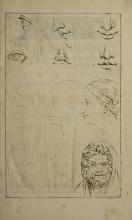
|
|
| Lairesse - New School - Page 2 |
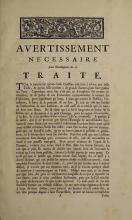
|
The text explains the author's approach to presenting an art treatise, emphasizing simplicity and clarity over elaborate language. The author reflects on the challenge of capturing the vastness of art, aiming to make the guide accessible and beneficial. Despite potential criticism, the author remains committed to offering insightful guidance to those seeking to advance their artistic skills. |
| Lairesse - New School - Page 3 |
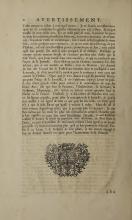
|
The author expresses gratitude for divine assistance in his work and acknowledges that while his style may be criticized as simple or childish, it is meant to be useful to its intended audience. He argues that simplicity can be more effective than elaborate styles in reaching young minds. The author emphasizes the educational value of the booklet in introducing the principles of fine arts and indicates future works may follow. |
| Lairesse - New School - Page 4 |
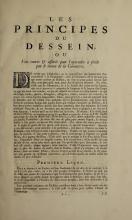
|
The text discusses the foundational importance of geometry in learning the art of drawing. It outlines a structured approach to mastering drawing, starting with basic principles and progressing through different stages of learning over time. Emphasis is placed on learning under a skilled master and maintaining dedication to truly succeed in the art. |
| Lairesse - New School - Page 5 |

|
The text provides an example of basic line principles for art students, emphasizing both theoretical understanding and practical application. It advises teachers on recognizing students' talents through basic exercises and stresses the importance of early practice and patience. The guidance encourages a balanced teaching approach, avoiding extreme leniency or strictness, using gentle instruction to better impact students. |
| Lairesse - New School - Page 6 |
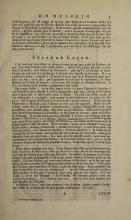
|
The text emphasizes the importance of patience in teaching art, gradually instructing young students while highlighting the value of brief and frequent explanations. It advises against pushing students into art forms they dislike, as enjoyment fosters learning more effectively. Demonstrations and gentle corrections are encouraged to inspire students and improve their skills progressively. |
| Lairesse - New School - Page 7 |
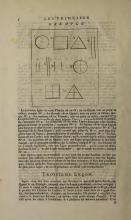
|
The text describes a series of geometric exercises using basic shapes like circles, squares, and triangles, intended to teach young students principles of drawing with compasses and rulers. It stresses practice in drawing various line orientations like perpendicular and horizontal and promises rewards for skill improvement. The instructions aim to motivate students by promising more intricate patterns to draw once basics are mastered. |
| Lairesse - New School - Page 8 |
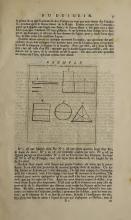
|
The text is a lesson on basic drawing principles, focusing on the use of tools like the compass and ruler. It provides examples with geometric shapes and guides students through measuring and drawing accurately. The text emphasizes understanding through practice and draws a parallel to learning to read in stages. |
| Lairesse - New School - Page 9 |
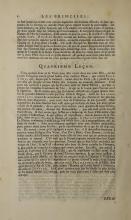
|
The text discusses the proper approach to teaching art, emphasizing the need for inspiring instruction rather than harsh discipline. It argues that students, like children, need gentle guidance to explore their talents and that skilled masters play a crucial role in a pupil's development. Nature and Art are portrayed as complementary forces in artistic education, and aspiring artists are encouraged to start with simple subjects before tackling more complex ones. |
| Lairesse - New School - Page 10 |
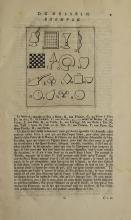
|
The text lists common objects such as a beer jug, wine glass, and apple, illustrating how they can be reduced to simple shapes for drawing practice. It emphasizes learning to draw these basic forms as they contain all the necessary linear elements for more complex art. Mastering these helps in achieving bold and accurate strokes, crucial for both sketching and finishing pieces. |
| Lairesse - New School - Page 11 |
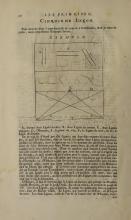
|
The text introduces basic principles for achieving precision and boldness in drawing, using a diagram as a teaching aid. Important concepts like parallel lines, horizon, and visual rays are discussed to help students understand and correctly apply perspective. The method emphasizes clarity and accuracy, using structured examples to prevent confusion and enhance learning. |
| Lairesse - New School - Page 12 |
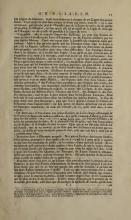
|
The text discusses the importance of remembering and distinguishing different lines in drawing, emphasizing how engaging with prints by renowned masters can inspire students. It stresses the educational value of separating prints and defined figures in different books to better direct student learning. The author argues for the benefits of learning from drawings made by masters and suggests that students should be encouraged with examples that ignite their imagination and drive toward perfection in art. |
| Lairesse - New School - Page 13 |
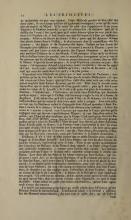
|
The text discusses the importance of patience and structured learning in art, suggesting that young students must be trained and equipped gradually with skills like handling a brush. It argues against the perception that focusing only on art could shame children, insisting instead on art's utility in shaping judgment and tranquility. Additionally, it posits that the pursuit of art complements personal virtues like temperance and wisdom, often exceeding in value beyond material wealth. |
| Lairesse - New School - Page 14 |
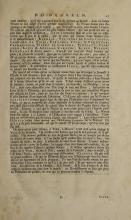
|
The text highlights the importance of a lively spirit in the mastery of art, emphasizing that renowned artists like Raphael and Leonardo da Vinci were full of vivacity. It stresses the significance of education as the foundation of society, guiding individuals beyond personal interests to public good. The piece warns against neglecting virtues and sciences in favor of luxury and excess, advocating for proper education and upbringing. |
| Lairesse - New School - Page 15 |
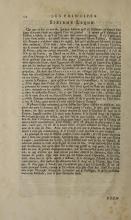
|
The text discusses the importance of deep understanding and thorough training in drawing to properly judge art. It warns against purchasing art based solely on superficial qualities like colors, and emphasizes the value of correctly holding tools like charcoal and pencils for sketching. Finally, it highlights the importance of sketching well, observing distances, and practicing accuracy as key aspects of mastering drawing. |
| Lairesse - New School - Page 16 |
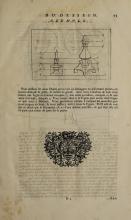
|
The text provides a guide for drawing two objects by dividing them into parts and marking lines at different heights with charcoal. It stresses the importance of geometry in ensuring accuracy, outlining a method for tracing figures step by step. The emphasis is on methodical drawing rooted in precise geometric principles. |
| Lairesse - New School - Page 17 |
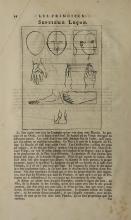
|
The text explains how to accurately copy the illustrated examples of human anatomy, focusing on the proportions of the face, hands, and feet. It describes the specific measurements and distances between features like the eyes, nose, and mouth, emphasizing regular proportionality in both men and women. Additional examples of individual features are provided for further practice and understanding of drawing techniques. |
| Lairesse - New School - Page 18 |
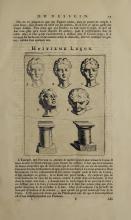
|
The text instructs students on enhancing their drawings by adding depth with shadows to create solid-looking bodies. Emphasizing technique, it advises using a red pencil and clear hatching without blending. The lesson provides examples of correct pencil handling, stressing careful and patient practice over hasty execution. Philosophers are quoted to highlight the importance of attention and restraint in drawing. |
| Lairesse - New School - Page 19 |

|
The document provides instructions on how to refine charcoal drawings using red pencil and erasing techniques to achieve natural shading and outlines. It discusses the use of hatching to create light and shadow variations, ensuring neither overpowers the sketch. The text emphasizes accurate, consistent strokes and understanding the interplay of light, shadow, and the form for effective drawing. |
| Lairesse - New School - Page 20 |
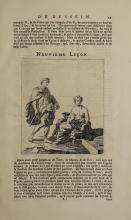
|
The excerpt discusses varying techniques for artistic hatching and emphasizes the importance of both hatching and contour in artwork. It introduces a ninth lesson, focusing on drawing whole figures, suggesting methods for structuring figures using charcoal with precise strokes. Students are advised on the benefits of careful observation before beginning their drawings. |
| Lairesse - New School - Page 21 |
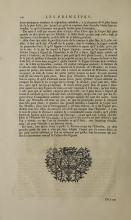
|
This section of the text from 'Les Principes' discusses the importance of understanding the spatial relationships between different parts of a figure, particularly in drawing. The author advises students to start with basic measurements using a central line and sketch major parts to ensure correct proportions. Emphasis is also placed on maintaining the spirit and natural movement in figures during the sketching process. |
| Lairesse - New School - Page 22 |
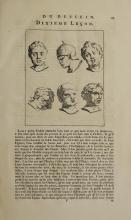
|
The text outlines a lesson in drawing where students are instructed in creating bas-reliefs with two figures, emphasizing proper techniques in lighting and positioning. It provides guidance on maintaining a suitable distance from the model and ensuring the object's height aligns with the artist's eye level. The lesson stresses understanding the light's impact on shadows, promoting a methodical approach to drawing and shading. |
| Lairesse - New School - Page 23 |
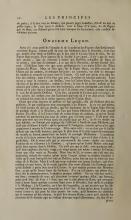
|
The text, described as the Eleventh Lesson, suggests methods for mastering drawing with white and black chalk on colored paper. It emphasizes gaining proficiency through imitation of highlighted drawings. The passage conveys the importance of practice and habit in achieving mastery in drawing. |
| Lairesse - New School - Page 24 |
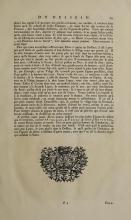
|
The text advocates investing in art-related resources, such as engravings and books, urging true art enthusiasts to commit fully to mastering the craft. It provides guidance on sketching a smiling face, emphasizing methodical progression through facial features while maintaining optimal light distribution. The passage concludes encouragingly, suggesting that mastering plaster figures is a key step before advancing to drawing from life. |
| Lairesse - New School - Page 25 |
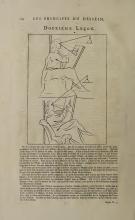
|
The text instructs students on maintaining correct posture and distance when drawing to view objects effectively. It emphasizes the importance of practicing proportion assessment and encourages parents or tutors to find proficient teachers for their children to succeed. The instructions are accompanied by diagrams demonstrating positioning and eye alignment. |
| Lairesse - New School - Page 26 |
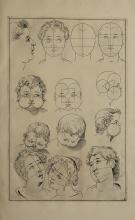
|
|
| Lairesse - New School - Page 27 |
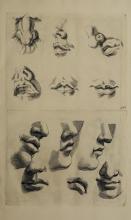
|
|
| Lairesse - New School - Page 28 |
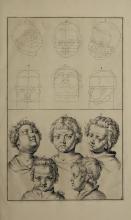
|
|
| Lairesse - New School - Page 29 |
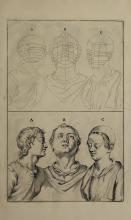
|
The image contains labels A, B, and C associated with the illustrations. The labels likely indicate different viewpoints or stages in the drawing process. The focus is on demonstrating proportions and detailing in head illustrations. |
| Lairesse - New School - Page 30 |
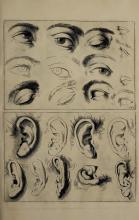
|
|
| Lairesse - New School - Page 31 |
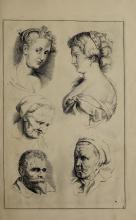
|
|
| Lairesse - New School - Page 32 |
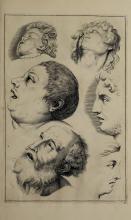
|
|
| Lairesse - New School - Page 33 |
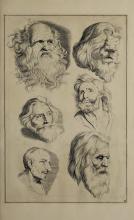
|
|
| Lairesse - New School - Page 34 |
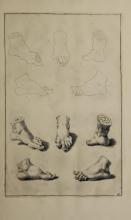
|
|
| Lairesse - New School - Page 35 |
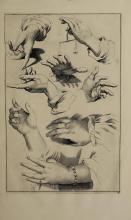
|
|
| Lairesse - New School - Page 36 |
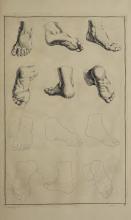
|
|
| Lairesse - New School - Page 37 |

|
|
| Lairesse - New School - Page 38 |
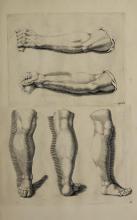
|
|
| Lairesse - New School - Page 39 |
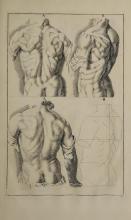
|
The text consists of labels 'A' and 'B' which likely annotate the images. The drawings depict detailed anatomical views of a human back. These annotations seem to relate to teaching the structure of muscles. |
| Lairesse - New School - Page 40 |
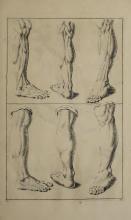
|
|
| Lairesse - New School - Page 41 |

|
|
| Lairesse - New School - Page 42 |
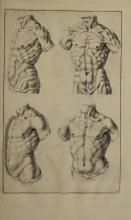
|
|
| Lairesse - New School - Page 43 |

|
|
| Lairesse - New School - Page 44 |
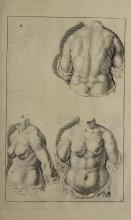
|
The image features a letter 'A', which could be a reference label for the anatomical illustrations. It does not contain additional textual content beyond this label. |
| Lairesse - New School - Page 45 |

|
This page includes the number '22' and primarily presents illustrations for artistic study. It features two sets of figures showing young children, moving from simple outlines to detailed drawings, illustrating a methodical approach to figure drawing. |
| Lairesse - New School - Page 46 |
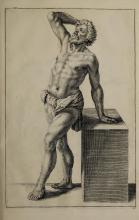
|
|
| Lairesse - New School - Page 47 |
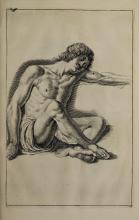
|
|
| Lairesse - New School - Page 48 |
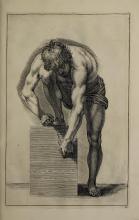
|
|
| Lairesse - New School - Page 49 |
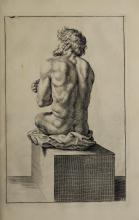
|
There is no text to summarize in this image, only a detailed illustration of a human figure from Gérard de Lairesse's book. |
| Lairesse - New School - Page 50 |
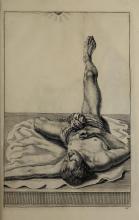
|
|
| Lairesse - New School - Page 51 |
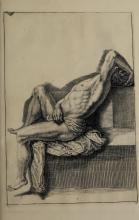
|
|
| Lairesse - New School - Page 52 |
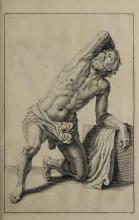
|
|
| Lairesse - New School - Page 53 |

|
|
| Lairesse - New School - Page 54 |
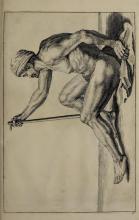
|
|
| Lairesse - New School - Page 55 |
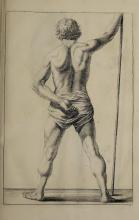
|
|
| Lairesse - New School - Page 56 |
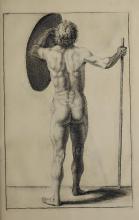
|
|
| Lairesse - New School - Page 57 |
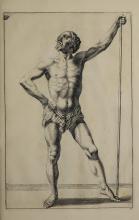
|
The page contains a detailed illustration of a male figure in a classical pose, showcasing anatomical study in art, typical of the teaching style in Lairesse's 1745 book on drawing. |
| Lairesse - New School - Page 58 |
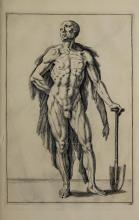
|
|
| Lairesse - New School - Page 59 |
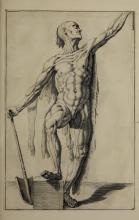
|
|
| Lairesse - New School - Page 60 |
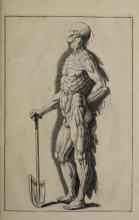
|
|
| Lairesse - New School - Page 61 |
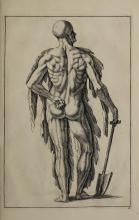
|
|
| Lairesse - New School - Page 62 |
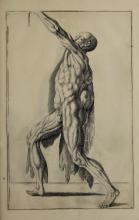
|
|
| Lairesse - New School - Page 63 |
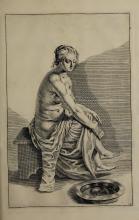
|
|
| Lairesse - New School - Page 64 |
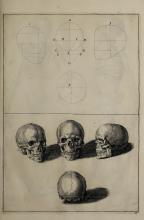
|
The image includes diagrams for constructing head shapes using letters and numbers, and illustrations of skulls from various angles. These are designed to help artists understand the structure and proportions of the human skull. The content is from a historical art book aimed at teaching drawing techniques. |
| Lairesse - New School - Page 65 |
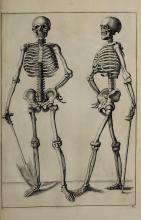
|
|
| Lairesse - New School - Page 66 |

|
|
| Lairesse - New School - Page 67 |
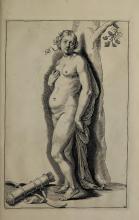
|
|
| Lairesse - New School - Page 68 |

|
|
| Lairesse - New School - Page 69 |
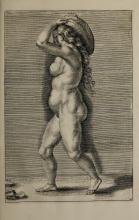
|
|
| Lairesse - New School - Page 70 |
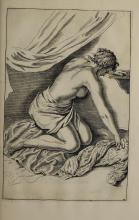
|
|
| Lairesse - New School - Page 71 |
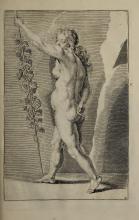
|
|
| Lairesse - New School - Page 72 |
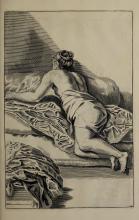
|
|
| Lairesse - New School - Page 73 |

|
|
| Lairesse - New School - Page 74 |
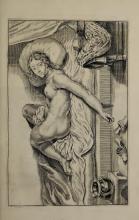
|
|
| Lairesse - New School - Page 75 |
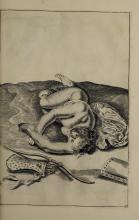
|
|
| Lairesse - New School - Page 76 |
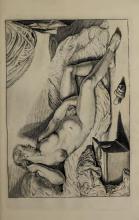
|
|
| Lairesse - New School - Page 77 |
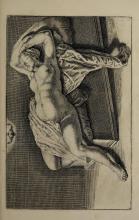
|
|
| Lairesse - New School - Page 78 |
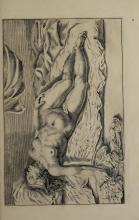
|
|
| Lairesse - New School - Page 79 |
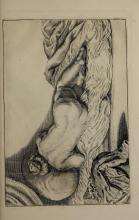
|
|
| Lairesse - New School - Page 80 |
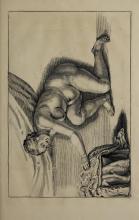
|
|
| Lairesse - New School - Page 81 |
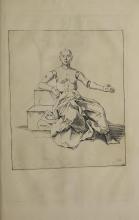
|
|
| Lairesse - New School - Page 82 |
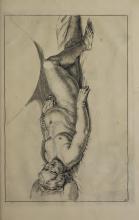
|
|
| Lairesse - New School - Page 83 |

|
|
| Lairesse - New School - Page 84 |
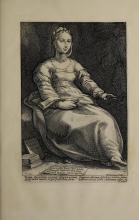
|
The text dedicates the image to Lady Isabella Savina of Bavaria, praising her virtues and noble heritage. It references her connection to knightly and theological traditions and praises divine attributes associated with her deeds. The inscription emphasizes her celebrated fame and achievements. |
| Lairesse - New School - Page 85 |

|
The text, in Latin, refers to Clio, the muse of history, who sings the deeds of leaders and kings. It emphasizes how Clio carefully preserves the mighty deeds and historical tales of heroes for eternity, protecting them from the ravages of time. Clio's guardianship ensures these stories extend over the ages into a long-lasting legacy. |
| Lairesse - New School - Page 86 |
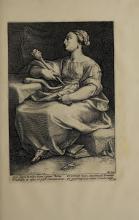
|
The text is a poetic reference to a muse named Thalia, who is involved in directing the actions of humble people and inciting disputes among fathers. It notes her role in sharing affection and participating in delicate games. |
| Lairesse - New School - Page 87 |
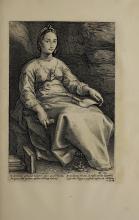
|
The text appears to be a poetic reference to Melpomene, the muse of tragedy, featuring themes and characters from Greek mythology. It emphasizes her role in portraying tragic stories equipped with the symbolic tragic buskin. Additional context is provided on specific mythological references and terms. |
| Lairesse - New School - Page 88 |
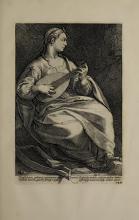
|
The text is a poetic depiction of Terpsichore, the muse of dance and chorus, setting down her lyre to enjoy a gentle melody. It describes how the music, played on a tortoise-shell lyre, enhances dance and kindles youthful affection. |
| Lairesse - New School - Page 89 |
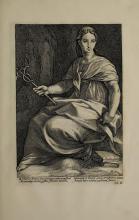
|
The text describes elements of rhetoric and eloquence, associating them with Polyhymnia, the Muse of hymns. It highlights her role in gracefully using gestures and speech. The translation clarifies references to Greek mythology. |
| Lairesse - New School - Page 90 |

|
The text is a poetic depiction of Euterpe, the muse of music in Greek mythology, highlighting her musical prowess with the flute and her presence in poetic traditions. It alludes to Greek cultural elements, including the Pythian Games and the legendary Aganippe spring. The text intertwines the arts with mathematical harmony, a classical concept. |
| Lairesse - New School - Page 91 |
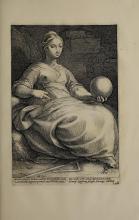
|
The text is a poetic description associated with one of the Muses, Erato, from Greek mythology. It highlights her role in spreading creativity and music across the world. This represents the inspiration and artistry revered in classical art. |
| Lairesse - New School - Page 92 |
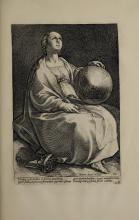
|
The text describes Urania, the muse of astronomy, showing the movements of the heavens and stars. It mentions the gentle promise of Venus's star and the predictions of the Hyades and stormy Orion. The passage concludes with a reference to the terrifying comet and its fiery flames. |
| Lairesse - New School - Page 93 |
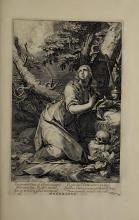
|
This text is a Latin poem meditating on themes of vanity, repentance, and divine grace, using the story of Mary Magdalene for illustration. It reflects on youthful attraction to earthly desires and the transformative power of Christ's acceptance. The poem urges self-reflection, portraying a shift from vanity to humility. |
| Lairesse - New School - Page 94 |
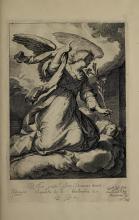
|
The text is a Latin phrase from Luke 2, recognizing a woman as blessed among women. It is likely part of a religious depiction consistent with the image of an angel in the artwork. |
| Lairesse - New School - Page 95 |
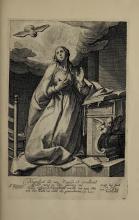
|
The text is a Latin excerpt from the "Magnificat," a biblical passage where Mary praises the Lord and speaks of the blessings of humility. It emphasizes Mary's role and her prophecy of being called blessed by future generations. The text credits the designers and printer, with notation of a royal privilege for printing. |
| Lairesse - New School - Page 96 |
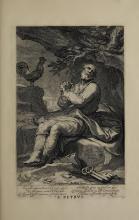
|
The text describes Saint Peter denying Christ three times before the rooster crowed and then retreating into solitary prayer. In prayer, Peter is depicted as gaining the ability to open and close the celestial poles, symbolizing his spiritual authority. The passage uses imagery of keys to represent access to heaven. |
| Lairesse - New School - Page 97 |
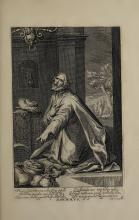
|
The text is a confession from Zacchaeus, a biblical figure, acknowledging his sins and expressing his desire for forgiveness. It highlights his transformation from a wealth-focused life to one of humility and generosity toward the poor. The passage is written in Latin and reflects themes of repentance and redemption. |
| Lairesse - New School - Page 98 |
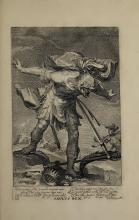
|
The text is a poetic depiction of King Saul, struggling with his own life due to many faults. In desperation, he ends his own life, as his weapon fails him. |
| Lairesse - New School - Page 99 |
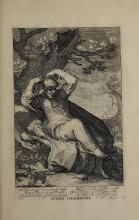
|
The text on the page includes a Latin description associated with Judas Iscariot, expressing despair and a wish for destruction. Judas reflects on his actions, lamenting the pact of betrayal and the resulting misery. The language captures a sense of urgency and regret, typical of narratives about Judas from historical contexts. |
| Lairesse - New School - Page 100 |
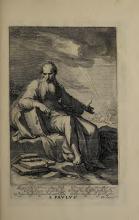
|
The text is a Latin verse reflecting on the spiritual and divine insights found in the books of Paul. It describes the abundant fulfillment one can gain through Christ, illustrated by the metaphor of a greater power striking down a horse with lightning, and also touches on the trials faced by God's chosen in the form of deceitful forces. The verse is a reflection on the wisdom and challenges depicted by St. Paul in the image. |
| Lairesse - New School - Page 101 |
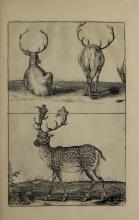
|
|
| Lairesse - New School - Page 102 |
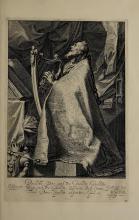
|
This image contains an excerpt from Psalm 46, calling for people to sing praises to God, who is king of all the earth. The text highlights the importance of singing wisely in worship. The surrounding artwork features a detailed depiction of a man playing a harp. |
| Lairesse - New School - Page 103 |
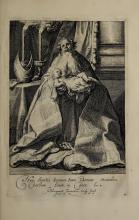
|
The text taken from a historic page includes a Latin phrase from the Bible, specifically Luke 2, "Now let your servant depart in peace." It credits Bloemaert as the inventor, noting the artistry involved. This aligns with the book's theme of exploring detailed and skilled artistic endeavors. |
| Lairesse - New School - Page 104 |
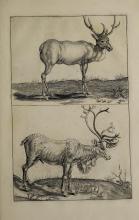
|
|
| Lairesse - New School - Page 105 |
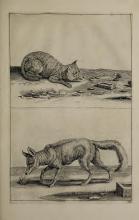
|
|
| Lairesse - New School - Page 106 |
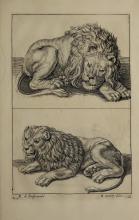
|
The text identifies the artist and the engraver of the lion illustrations: R. de Vorst as the engraver and R. Zavery as the illustrator. |
| Lairesse - New School - Page 107 |
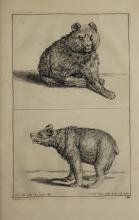
|
The text identifies the creators of the engravings: R. Savery as the artist and R. de Vos as the engraver. It is a brief attribution of authorship for the artwork on the page. |
| Lairesse - New School - Page 108 |
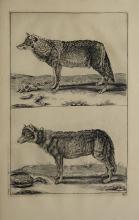
|
|
| Lairesse - New School - Page 109 |

|
The page features two illustrations of sheep by Gérard de Lairesse, intended for educational purposes in drawing. These images demonstrate how to capture animal forms and textures effectively. |
| Lairesse - New School - Page 110 |
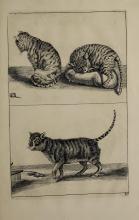
|
|
| Lairesse - New School - Page 111 |
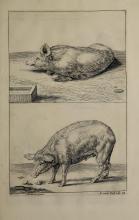
|
The text includes the names of the artists responsible for the illustrations: R. Savery and R. vander Vaef, along with the number 88. These annotations accompany two detailed engravings of pigs, showcasing resting and active postures, likely intended for artistic instruction. |
| Lairesse - New School - Page 112 |
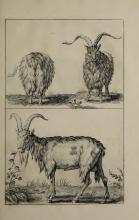
|
This page contains detailed goat illustrations, likely used for studying animal form in art. It fits within the context of Lairesse's instructional drawing book. |
| Lairesse - New School - Page 113 |
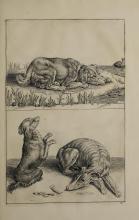
|
|
| Lairesse - New School - Page 114 |
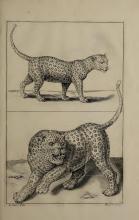
|
The image contains text indicating the drawing was made by R. Sauersj. The focus is on the engravings displaying a leopard in different poses to illustrate artistic techniques. |
| Lairesse - New School - Page 115 |
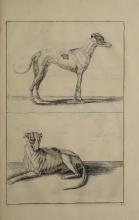
|
There is a single page number, '92', visible in the image. It contains two detailed illustrations of a dog in different poses, useful for art students to understand animal anatomy. |
| Lairesse - New School - Page 116 |
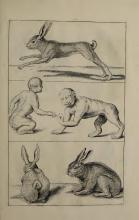
|
The page contains images of animals, showcasing details in anatomy and movement. Three separate sections illustrate rabbits and monkeys in various poses. These studies demonstrate techniques for representing form and motion in art. |
| Lairesse - New School - Page 117 |
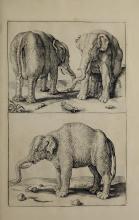
|
|
| Lairesse - New School - Page 118 |
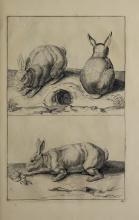
|
|
| Lairesse - New School - Page 119 |
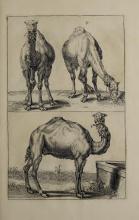
|
|
| Lairesse - New School - Page 120 |
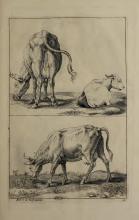
|
The image contains sketches of cows attributed to Robbert de Vosch. These drawings demonstrate different positions and views of the animals, highlighting anatomical features. |
| Lairesse - New School - Page 121 |
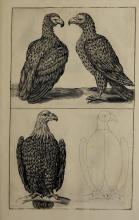
|
|
| Lairesse - New School - Page 122 |
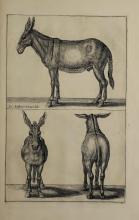
|
The text appears to credit the artist, R.Sauci, for the drawings of the donkey. These illustrations are likely used to demonstrate animal anatomy for art education. |
| Lairesse - New School - Page 123 |
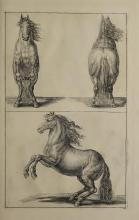
|
|
| Lairesse - New School - Page 124 |
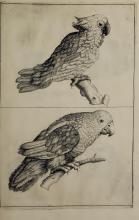
|
|
| Lairesse - New School - Page 125 |
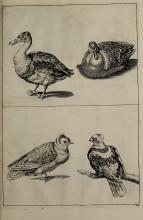
|
|
| Lairesse - New School - Page 126 |
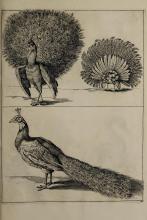
|
|
| Lairesse - New School - Page 127 |
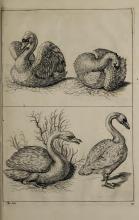
|
The image contains minimal text indicating an artist's mark and a page number. The primary content is the detailed illustration of swans in various poses, likely serving as a drawing reference in the book by Gérard de Lairesse. These sketches demonstrate the careful study of avian anatomy and posture. |
| Lairesse - New School - Page 128 |
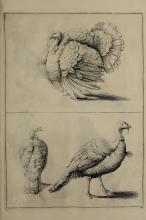
|
The image consists of illustrations of birds likely intended for teaching drawing techniques from the 18th century art book by Gérard de Lairesse. It focuses on the detailed representation of the birds' anatomy and plumage. These drawings serve as examples of the style and accuracy emphasized in art instruction during that period. |
| Lairesse - New School - Page 129 |
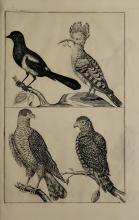
|
|
| Lairesse - New School - Page 130 |
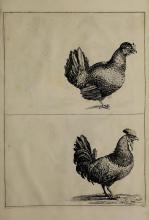
|
|
| Lairesse - New School - Page 131 |
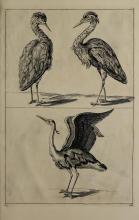
|
|
| Lairesse - New School - Page 132 |
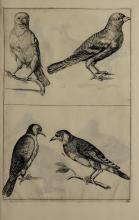
|
|
| Lairesse - New School - Page 133 |
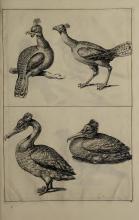
|
|
| Lairesse - New School - Page 134 |
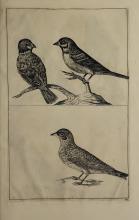
|
|
| Lairesse - New School - Page 135 |
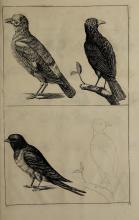
|
|
| Lairesse - New School - Page 136 |
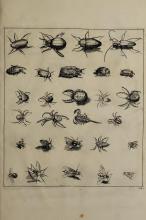
|
|
| Lairesse - New School - Page 137 |
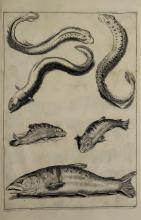
|
|
| Lairesse - New School - Page 138 |
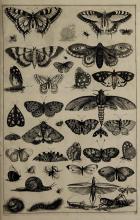
|
|
| Lairesse - New School - Page 139 |
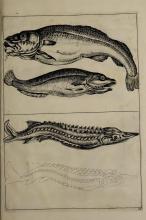
|
|
| Lairesse - New School - Page 140 |
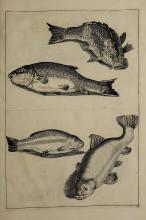
|
|
| Lairesse - New School - Page 141 |

|
|
| Lairesse - New School - Page 142 |

|
COPYRIGHT © 2025 STUDY DRAWING. ALL RIGHTS RESERVED.